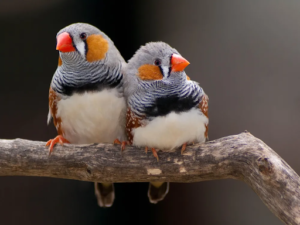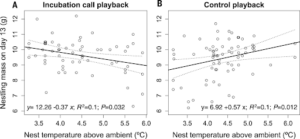The Zebra Finch Weather Forecast: A New Form of Bird Communication
Written by: Claudia Kowal
Introduction
Similar to people, most bird species use vocalizations to communicate with each other. Typically, birds vocalize through songs and calls, warning others of predators, nearby food sources, or to mate (Thompson, 2014). However, recent research has shown that a particular species of bird, the zebra finch, has utilized a new form of communication: in ovo. This refers to parent birds vocalizing to communicate with their offspring while still inside the egg. A study done at the University of Deakin in Australia showed the cause of this special call, mainly rapid changes and temperature, and its effects on the offspring.
How does it work?
The researchers observed a special call made by zebra finches, a few days before their eggs were predicted to hatch. Strangely enough, this call was only made when temperatures exceeded 78°F. To test this hypothesis, researchers removed eggs from these outdoor nests (replacing them with fake eggs) and placed the original eggs in a controlled environment. They then separated the eggs into two groups, playing the special call for only half of them. After placing the eggs back in the outdoor nests and allowing them to hatch, the researchers observed that those who heard the special call were, on average, significantly smaller than those who had not (Learn, 2016).
They attributed these results to a phenomenon known as Bergmann’s rule: the claim that smaller birds living in warmer climates will have a survival advantage over larger birds. This is because a smaller body mass decreases the ratio of volume to surface area, which can minimize heat retention in mammals and birds (Bogin et al., 2022). Some hypothesize that this rule not only applies to differences in where species geographically reside, but this rule can also apply to sudden changes in climate, especially in developing individuals (Fiedler, 2016). This case of Bergmann’s rule was very clearly demonstrated through the zebra finch study.
Figure 1
 Two male Zebra Finches perched on a branch.
Two male Zebra Finches perched on a branch.
Source: Smithsonian Magazine
Effects into Adulthood
By studying hatchlings as they grew up, researchers determined that this special call affected zebra finches well into adulthood. For one, they found that hearing the call, on average, decreased the size of birds even past early development, up until birds reached maturity. Additionally, researchers found that as adult birds searched for their own nests, those who heard the special call as hatchlings tended to choose nests in warmer locations than those who hadn’t heard the call. Researchers also hypothesized that hearing the call as hatchlings could increase their ability or likelihood for the adult birds to reciprocate this call to their own offspring in the future (Learn, 2016).
This research contributes to an idea known as epigenetics, or behavior’s impact on gene expression, particularly in the early development of individuals (Sapolsky, 2018). In other words, epigenetics resolves the popular argument of “nature versus nurture,” claiming that both of these factors play a part in affecting the traits and characteristics of an individual. A common narrative seen in epigenetics, as demonstrated in the zebra finch research, is that parents behave in some way around their offspring early on, affecting their development and behaviors for the rest of their lives, for better or worse. In the case of the zebra finch, the parent’s call is done intentionally to help offspring better survive rapidly changing climates.
Figure 2

A linear regression model of the temperature of nests versus the nestling’s mass.
Source: Science
Conclusion
While providing important information on how zebra finches adapt to the changing climate, it also helped provide support for new behavioral mechanisms. The knowledge that parent birds can communicate with their offspring in ovo has been around for quite some time, but this was the first published study that provided a potential utility for this form of communication. Additionally, this study provided potential support for Bergmann’s rule of size in mammals and birds, as well as the idea of epigenetics as a whole. Overall, this real-life instance of in ovo has many implications for the field of behavioral biology and genetics.
References and Sources
Bogin, B., Hermanussen, M., & Scheffler, C. (2022). Bergmann’s rule is a “just-so” story of human body size. Journal of Physiological Anthropology, 41(1). https://doi.org/10.1186/s40101-022-00287-z
Fiedler, W. (2016). Bergmann Rule – an overview | ScienceDirect Topics. Www.sciencedirect.com. https://www.sciencedirect.com/topics/earth-and-planetary-sciences/bergmann-rule
Learn, J. R. (2016, August 16). Birds Sing to Their Eggs, and This Song Might Help Their Babies Survive Climate Change. Smithsonian Magazine. https://www.smithsonianmag.com/science-nature/birds-talk-their-eggsand-song-might-help-their-babies-deal-climate-change-180960168/
Mariette, M. M., & Buchanan, K. L. (2016). Prenatal acoustic communication programs offspring for high posthatching temperatures in a songbird. Science, 353(6301), 812–814. https://doi.org/10.1126/science.aaf7049
Sapolsky, R. M. (2018). Behave : the biology of humans at our best and worst. Penguin Books, an imprint of Penguin Random House LLC.
Thompson, M. (2014, August 12). Bird Song. Academy.allaboutbirds.org. https://academy.allaboutbirds.org/birdsong/#:~:text=Songbirds%20learn%20their%20songs%20and
Wu, K. J. (2018, August 7). Zebra Finches Dream a Little Dream of Melody. Smithsonian Magazine. https://www.smithsonianmag.com/science-nature/zebra-finches-dream-little-dream-melody-180969925/